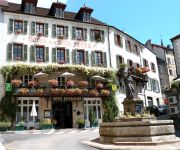Facts and Data
Webpages:
Official Unesco Page
Saline Royale (in French)
La Grande Saline de Salins-les-Bains (in French)
Basis Data:
Unesco World heritage since: 1982
Size of heritage: 10 ha
- Buffer zone: 585 ha
Coordinates:
Longitude: 5,876°
Latitude: 46,938°
Summary
The Royal Saltworks of Arc-et-Senans, near Besançon, was built by Claude Nicolas Ledoux. Its construction, begun in 1775 during the reign of Louis XVI, was the first major achievement of industrial architecture, reflecting the ideal of progress of the Enlightenment. The vast, semicircular complex was designed to permit a rational and hierarchical organization of work and was to have been followed by the building of an ideal city, a project that was never realized.
Location on Map
Show bigger map on Openstreetmap
From the Great Saltworks of Salins-les-Bains to the Royal Saltworks of Arc-et-Senans, the Production of Open-pan Salt
The UNESCO World Heritage site "From the Great Saltworks of Salins-les-Bains to the Royal Saltworks of Arc-et-Senans, the Production of Open-pan Salt" is located in the eastern part of France, specifically at coordinates N46 56 15 E5 52 35. This site is a testament to the historical significance and technological advancements in the production of salt during the 18th and 19th centuries.
History
The history of this UNESCO World Heritage site dates back to the Middle Ages when the extraction of salt became a vital economic activity in the region. Salins-les-Bains, the first part of the site, was established in the 13th century and quickly became one of the most important saltworks in Europe. The salt was extracted from underground brine sources and processed using the open-pan method, which involved evaporating the water to obtain the salt crystals.
In the 18th century, the Royal Saltworks of Arc-et-Senans was constructed under the direction of architect Claude-Nicolas Ledoux. This architectural masterpiece was designed as a self-contained industrial complex, with buildings and infrastructure specifically tailored to the production of salt. The site featured a semicircular layout, with the central building known as the "Pavillon du Directeur" serving as the administrative hub.
During the French Revolution, the saltworks were nationalized and continued to operate until the early 20th century. However, with the advent of modern salt production techniques, the traditional open-pan method became obsolete, leading to the closure of the saltworks in 1962.
Current State
Today, the Great Saltworks of Salins-les-Bains and the Royal Saltworks of Arc-et-Senans have been meticulously preserved and restored, allowing visitors to experience the rich history and architectural grandeur of these sites.
The Great Saltworks of Salins-les-Bains, now a museum, offers a fascinating insight into the salt production process. Visitors can explore the underground galleries, where brine was extracted, as well as the various buildings that housed the different stages of salt production. The museum showcases the tools, machinery, and techniques used by salt workers throughout the centuries, providing a comprehensive understanding of this once vital industry.
The Royal Saltworks of Arc-et-Senans, on the other hand, has been transformed into a cultural center. The main building, the Pavillon du Directeur, now houses exhibitions and events that celebrate the architectural and historical significance of the site. The surrounding gardens, designed by Ledoux himself, offer a serene and picturesque setting for visitors to explore.
Both sites have been recognized by UNESCO for their outstanding universal value, representing a significant period in the history of salt production and industrial architecture. The preservation and promotion of these sites not only contribute to the understanding of our past but also serve as a reminder of the importance of cultural heritage in shaping our present and future.
Hotels and places to stay
Hôtel des Deux Forts Hôtel Charles Sander
residence Charles Sander Logis
Castel Damandre
Grand Hotel des Bains Logis
CHATEAU DE GERMIGNEY
Videos from the area
Videos provided by Youtube are under the copyright of their owners.










